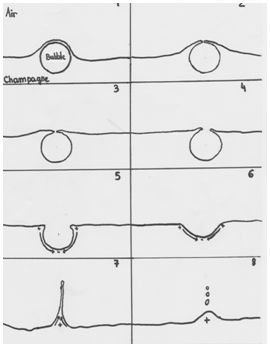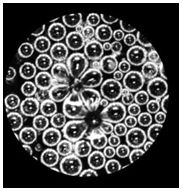A bubble on the surface of champagne is an almost perfect sphere that is separated from the atmosphere by an extremely thin film of champagne: the force which permits the film to exist is called the the surface tension. Two types of champagne bubble bursting can be observed dictated by the presence or absence of surfactant molecules: the spontaneous and the delayed bursting.
This first phenomenon is very simple, it can be described by the progressive thinning of the liquid film as the bubble rises. The film disintegrates when the champagne’s capillarity does not suffice to its cohesion, the surfactant molecules being very few.
The second phenomenon, the delayed burst, is a little more complex and is related to the presence of many surfactant molecules that stiffen the wall of the bubble, allowing it to survive longer. A double wall of surfactant molecules is thus formed when the bubble arrives at the surface of the champagne, separated by the thin liquid film.
However, no matter if the bursting is delayed or spontaneous, it always occurs, no bubble being eternal. The next stage is identical in both cases. The champagne film thins rapidly under the combined action of the buoyancy force and the capillary pressure. This phase is called the “drainage” phase. In about one millisecond, it reaches a critical thickness of about 100 nm and thus becomes too vulnerable to withstand the vibrations and very subtle temperature changes: the bubble bursts. The bursting process is extremely fast. First a small circular hole appears at the top of the film -so where it is the thinnest- and spreads at a speed of about 10 m.s-1 under the effect of surface tension. This process takes only a few tens of microseconds.

After this burst a cavity appears on the surface of the liquid. However, the liquid, according to its properties, seeks very quickly to return to an horizontal position: a hydrodynamic process therefore begins, to respect these fundamental properties. This phenomenon occurs systematically in the same way: the small cavity caused by the bursting collapses on itself and causes a thin streak of champagne to shoot up at about 1 m.s-1. This speed causes the liquid to become very quickly unstable, and the streak of champagne thus breaks into droplets. The champagne’s surface is then dotted with hundreds of tiny streaks breaking in turn into droplets. These droplets have a major role to play in tasting; they accelerate the escape of aromas.
The cavity caused by the bursting of the bubble has consequences, especially if the bubble burst just after the fall of the foam, that is to say in the few tens of seconds during which the surface of the champagne has a monolayer of bubbles. When a bubble bursts under these conditions, it creates a cavity that distorts the adjoining bubbles. They are thus violently drawn towards the depression in the lower part of the cavity caused by the collapse of the bubble. This stretching is the result of the opposition between the depression under the surface and the overpressure in the bubble’s film. The fluid, according to its properties, always moves from high pressure areas to low pressure areas.
However, the bubbles do not burst in a "cascade" as we might think, (the depression causing them to burst and so on) but manage to return to their initial shape. However, during the drainage phase and the collapse of aqueous foams, these "cascade" can occur. Beautiful images in which the arrangement of the bubbles makes them look like flowers can then be observed thanks to great precision tools.

These "explosions" also allow the sending in the air of a small amount of a highly charged in surfactants liquid that is very aromatic, and therefore plays a very important role in tasting.
FOAM
We know that the more surfactants are present in the liquid, the longer the bubbles survive on the surface of the champagne. Therefore, when new bubbles arrive, they do not burst. The cluster of bubbles forms the foam. Thus, the more surfactant, the more foam. To illustrate this, we can compare lemonade, beer and of course champagne. When these three liquids are poured into measuring cylinders, we can notice that the foam formed by the lemonade stays only a few seconds, the foam formed by the champagne lasts a few moments more, and finally, the foam generated by the beer lasts several minutes. It is known that the concentration of surfactants = beer <champagne <lemonade. We can deduce that the higher the surfactant concentration, the greater the "lifetime" of the foam. In short, life = number of molecules present / number of bursting bubbles per time unit.
The decrease of the foam is due on one hand to pressure, so the weight of bubbles i.e. gravity. Thus, the greater the foam, the more pressure on the bubbles at the bottom is high, which results in either their bursting, or their merging, which weakens the structure considerably.
The merging is therefore another factor in the decrease of the foam because when the volume of the bubble increases, the surfactant concentration stays almost unchanged. The wall is of the bubble is thus weakened and the bubble is therefore much more fragile.
The foam has a very fragile structure as the bubbles form a pyramid, a network where champagne can flow; and, as gravity pulls the liquid down, we can observe the flow of champagne and therefore the thinning of the champagne film between the double wall of surfactants.
